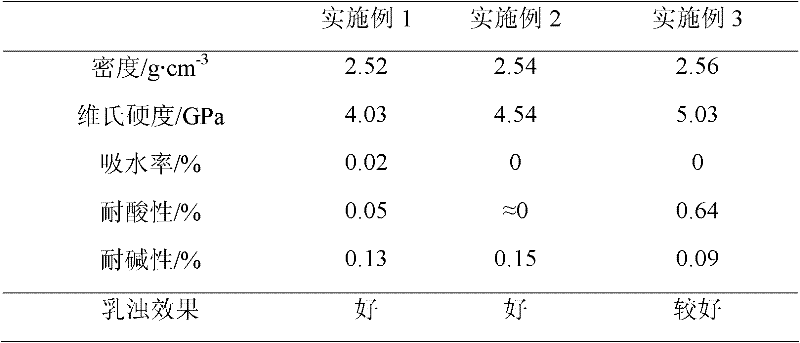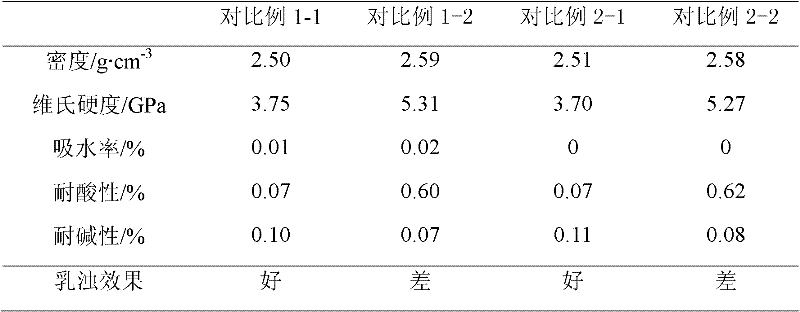Na2O-CaO-SiO2 opaque glass and preparation method thereof
A 1.na2o-cao-sio2, opaque glass technology, applied in the field of building materials, can solve the problems of large crystallization tendency, easy precipitation of large particles, poor process control, etc., to improve glass hardness, opacity, etc. The effect of improved performance and simple process
- Summary
- Abstract
- Description
- Claims
- Application Information
AI Technical Summary
Problems solved by technology
Method used
Image
Examples
Embodiment 1
[0028] Embodiment 1, a kind of Na 2 O-CaO-SiO 2 The preparation method of opal glass comprises the following steps:
[0029] 1), ingredients:
[0030] SiO 2 64.0 parts, CaO 7.0 parts, Na 2 CO 3 27.36 parts, Al 2 o 3 2.0 copies, K 2 CO 3 2.93 parts, MgO 3.0 parts, P 2 o 5 5 parts and ZrO 2 1 serving.
[0031] Namely: Na 2 CO 3 27.36 parts replaced Na 2 O16.0 parts, K 2 CO 3 2.93 copies replaced K 2 O 2 parts.
[0032] 2), fully mix all the ingredients in step 1), then place in a furnace and heat to 1450°C to melt and keep warm for 3 hours to obtain a clear and uniform molten glass;
[0033] 3) Pour the molten glass obtained in step 2) into a mold for molding and allow it to cool naturally and slowly to room temperature to finally obtain uniform milky white opalescent glass.
Embodiment 2
[0034]Embodiment 2, a kind of Na 2 O-CaO-SiO 2 The preparation method of opal glass comprises the following steps:
[0035] 1), ingredients:
[0036] SiO 2 69.0 parts, CaO 6.0 parts, Na 2 CO 3 27.36 parts, Al 2 o 3 1.0 copies, K 2 CO 3 0.73 parts, MgO 1.5 parts, P 2 o 5 4 parts and ZrO 2 2 servings.
[0037] Namely: Na 2 CO 3 27.36 parts replaced Na 2 O16.0 parts, K 2 CO 3 0.73 parts replaced K 2 O 0.5 parts.
[0038] 2), fully mix all the ingredients in step 1), then place in a furnace and heat to 1450°C to melt and keep warm for 3 hours to obtain a clear and uniform molten glass;
[0039] 3) Pour the molten glass obtained in step 2) into a mold for molding and allow it to cool naturally and slowly to room temperature to finally obtain uniform milky white opalescent glass.
Embodiment 3
[0040] Embodiment 3, a kind of Na 2 O-CaO-SiO 2 The preparation method of opal glass comprises the following steps:
[0041] 1), ingredients:
[0042] SiO 2 59.0 parts, CaO 8.0 parts, Na 2 CO 3 34.20 parts, Al 2 o 3 2 copies, K 2 CO 3 2.93 parts, MgO 3.0 parts, P 2 o 5 1.0 parts and ZrO 2 5 servings.
[0043] Namely: Na 2 CO 3 34.20 parts instead of Na 2 O 20.0 parts, K 2 CO 3 2.93 instead of 2.
[0044] 2), fully mix all the ingredients in step 1), then place in a furnace and heat to 1450°C to melt and keep warm for 3 hours to obtain a clear and uniform molten glass;
[0045] 3) Pour the molten glass obtained in step 2) into a mold for molding and allow it to cool naturally and slowly to room temperature to finally obtain uniform milky white opalescent glass.
[0046] The performance corresponding to each embodiment of table 1
[0047]
PUM
 Login to View More
Login to View More Abstract
Description
Claims
Application Information
 Login to View More
Login to View More - R&D
- Intellectual Property
- Life Sciences
- Materials
- Tech Scout
- Unparalleled Data Quality
- Higher Quality Content
- 60% Fewer Hallucinations
Browse by: Latest US Patents, China's latest patents, Technical Efficacy Thesaurus, Application Domain, Technology Topic, Popular Technical Reports.
© 2025 PatSnap. All rights reserved.Legal|Privacy policy|Modern Slavery Act Transparency Statement|Sitemap|About US| Contact US: help@patsnap.com


